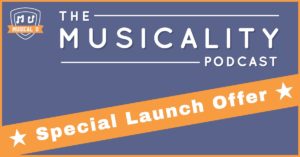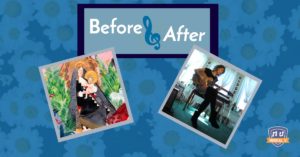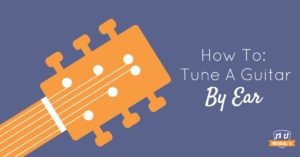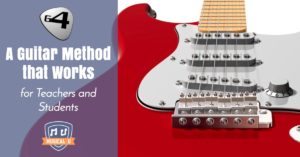At the turn 20th century, a quiet, humble six-stringed instrument was fitted with steel strings – growing louder, more versatile, and more popular. A few decades later – amplified with electronic pickups – the guitar continued its rapid evolution into the monster musical machine it is today.
This week Musical U pays homage to this musical wonder of the world with a simple guitar/voice cover of a high-production Father John Misty song, a revolutionary guitar learning method, and a complete guide to how – and why – to tune your guitar by ear.
So you’re not a guitar player (even though you wish you were!)? Let’s begin with something for everyone who wants to become more free and natural in their musical expression – a new giveaway.
That’s right,
Musical U is giving away free stuff
… to help you grow in your musicality. Why?
In his quest to help more musicians acquire the freedom and naturalness of expression they desire, Musical U founder Christopher Sutton has been reaching out to the greatest minds in modern musicality education. Into their methods, and also into their backstories to learn more about their own musical journeys.
 In addition, Christopher has been inspired to produce his own series of teaching podcasts on the musicality questions you care about most.
In addition, Christopher has been inspired to produce his own series of teaching podcasts on the musicality questions you care about most.
The results are in and we have a fantastic lineup of podcasts scheduled to launch next week.
If you’ve been hanging around Musical U at all the past month, you can tell that we’ve been pretty pumped about this new Musicality Podcast series. You may even have grabbed a free subscription to the Podcast Insiders to stay on top of all the podcast news and promotions.
So, in celebration of the launch, we’re giving away an amazing array of memberships, apps, software, worksheets – from Musical U and many other musicality educators.
So head over to The Musicality Podcast Launch: Prize Giveaway! to find out how you can fill your musical toolbox in one fell swoop – for free!
From a Big Band to a Single Guitar
 In our Before and After posts, we’ve been learning so much by examining the process of transforming an original tune into a cover. This week, we witnessed the power of a
In our Before and After posts, we’ve been learning so much by examining the process of transforming an original tune into a cover. This week, we witnessed the power of a
single guitar.
Kendra McKinley breaks down all Father John Misty’s entire band into a jazzy arrangement on her gold top and soars over the whole thing with passionate, heartfelt vocals. See how she does it with a look at Before and After: Covering Father John Misty.
“When You’re Smiling and Astride Me” doesn’t follow the standard pop music arrangement, but it works precisely due to the way that the song builds. Learn more about creating interesting arrangements from Sound Shock.
Father John Misty frequently starts songwriting with just his guitar and voice, which leads to the chords and melody being the main driving factor behind the song. This strategy of starting very simply is how many of the greatest songs that you may know of had their beginnings. Start your songwriting journey (on any instrument!), with Guitar Adventures.
To create this cover song, Kendra had to change the key to fit within her vocal range. This is a very common practice for many musicians. Key changes can also have the additional impact of changing the color of a song! To do this, you need to become comfortable with the art of transposition. From the Top lays out four easy steps to master transposition.
A common practice for guitar players is to use a capo to quickly change the key of a song. This has the added benefit of not needing to change chord voicings “on the fly” and keep open strings available to your harmonies. To get started using a capo, with Eric Blackmon Music:
Tune Up
With all the gizmos and gadgets available, what’s the point of tuning your guitar by ear?
Musicality means that you are connected with your instrument, that you really hear what you’re doing. Sure, you can learn to press the “right” buttons in the “right” order, but are you really making music?
 Connecting with your instrument is a deeply satisfying step to bringing out and expressing the music that is within you. And tuning your guitar by ear – apart from being a very learnable and fun skill – can actually become a foundational step to your ear training.
Connecting with your instrument is a deeply satisfying step to bringing out and expressing the music that is within you. And tuning your guitar by ear – apart from being a very learnable and fun skill – can actually become a foundational step to your ear training.
Learn more about the art of tuning – including all those cool alternate tunings – as you learn How To Tune A Guitar By Ear.
Sometimes it seems as though every guitar player has their unique way to tune their instrument. It can almost become a habit, your own private ritual before beginning the practice session. Another secret trick is to use harmonics when tuning – with these high pitches, it can be easier to hear the waves that are present when strings are not in tune. Justin Guitar has this great lesson to get you started tuning your guitar with harmonics.
How are interval ear training and tuning a guitar related? And can interval ear training supercharge your ability to quickly tune your guitar? Absolutely! David Dimuzio has some super tips on tuning using intervals:
You did it! Your guitar is perfectly in tune (by ear) and you’re ready to start playing. Only to come back the next day and it sounds just as bad as before your careful tuning. Why don’t guitar strings simply stay in tune after all your meticulous work? And what about those other tuning problems? Roadie Tuner knows all about why guitars go out of tune – and what to do about it.
We talk a lot about learning to play by ear, tune by ear, and developing your musical ear. How will this change as you get older and (inevitable) need some sort of hearing aid? Does this mean that your days of enjoying music are over? Not at all! Hearing Aids For Music details one musician’s journey through hearing loss, and how he overcame it!
B4 G4 – and after
With all massive throngs picking up the guitar, you may be surprised to learn that the most popular method book was published over 40 years ago, and was never tested on real students!
What’s more, most method books ever since have blindly followed the same model. And the centuries-old one-to-one private lesson model still pervades.
 David Hart loved teaching guitar. But he was frustrated with both the inefficiency of the old model for the student’s learning, as well was the near-impossibility of making a decent living as a guitar teacher. He tried starting his own music school, but it was still not enough.
David Hart loved teaching guitar. But he was frustrated with both the inefficiency of the old model for the student’s learning, as well was the near-impossibility of making a decent living as a guitar teacher. He tried starting his own music school, but it was still not enough.
Enter the G4 guitar method.
David methodically tried and tested more efficient ways to learn what matters most to guitar students and came up a system that his students and his teachers absolutely love. We spoke with him at length about this Guitar Method that Works – for Teachers and Students.
David started the conversation by talking about the 80/20 principle, and how that applies to music. Wait a minute… what is the 80/20 principle? While we cannot do it justice here, Mark Samples talks all about how this fascinating 80/20 principle can be applied to fight against perfectionism with productivity deep-hacks for musicians.
Learning music has benefits that far exceed just the act of playing your instrument. The connections between neuroscience and music education have been long established and continue to be a way to strengthen your brain. For more information about the benefits of music education and how to memorize music faster, this fascinating podcast from Becoming Superhuman is a great listen!
Many want to learn music or improve their learning, but don’t know how to get past their obstacles. Having a system in place, that guides you through the process of learning a new skill, is highly valuable and will keep you on the right path. Here is a wonderful guide on how to learn the art of music production as fast as possible. These principles can be applied to almost anything that you are trying to accomplish!
The internet has changed how we learn and interact with the world. The amount of information available is seemingly unlimited, and this increases our ability to learn more about topics we are passionate about. In addition to the resources at Musical U, there are many other great educators that can be found in the online space. For a list of online games that can help you in your quest to become a better musician, check out TpT Music Crew.
Guitar and Beyond
With all the info out there, and our exposure to so much astounding musical creativity, musicians of the 21st century are finding out that there are better ways to learn.
So enjoy a guitar method that works, sharpening your tuning ear, and creating beautiful guitar covers. And get ready to launch into musical freedom with the Musicality Podcast Giveaway.
The post Musicality Podcast Giveaway, Tune Your Guitar, G4 Guitar Method, and a Misty Cover appeared first on Musical U.